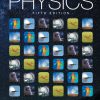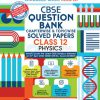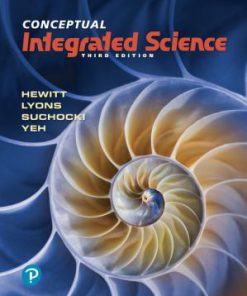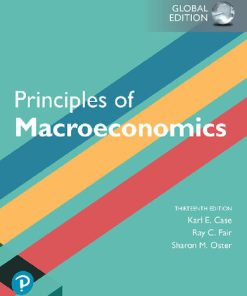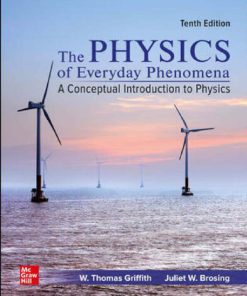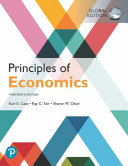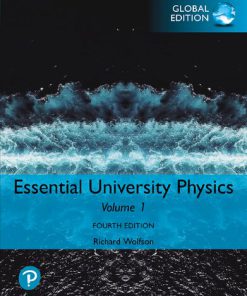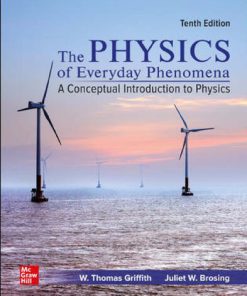Conceptual Physics 13th Edition by Paul Hewitt ISBN 9781292437330 1292437332
$50.00 Original price was: $50.00.$25.00Current price is: $25.00.
Conceptual Physics 13th Edition by Paul Hewitt – Ebook PDF Instant Download/Delivery: 9781292437330 ,1292437332
Full download Conceptual Physics 13th Edition after payment
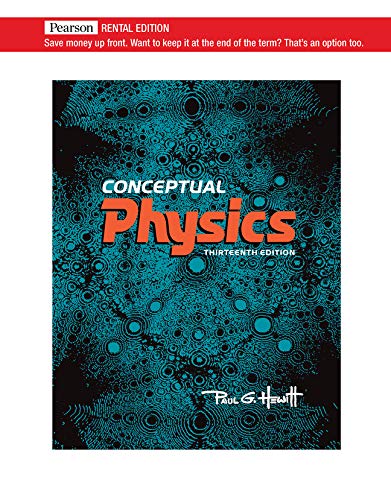
Product details:
ISBN 10: 1292437332
ISBN 13: 9781292437330
Author: Paul Hewitt
Conceptual Physics defined the liberal arts physics course over 30 years ago and continues as the benchmark. Guided by the principle of concepts before calculations, the text engages students with real-world analogies and imagery. Together they build a strong conceptual understanding of physical principles, ranging from classical mechanics to modern physics.
The 13th Edition continues to make physics delightful with informative and fun Hewitt-Drew-It screencasts and updated content and applications. Expanded instructor resources provide a wealth of support with guidance on how and when to use them.
Conceptual Physics 13th Edition Table of contents:
Chapter 1 About Science
1.1 Scientific Measurements
How Eratosthenes Measured the Size of Earth
Size of the Moon
Distance to the Moon
Distance to the Sun
Size of the Sun
Mathematics—The Language of Science
1.2 Scientific Methods
The Scientific Attitude
Dealing with Misconceptions
1.3 Science, Art, and Religion
1.4 Science and Technology
1.5 Physics—The Basic Science
1.6 In Perspective
Chapter 1 Review
Summary of Terms (Knowledge)
Reading Check Questions (Comprehension)
1.1 Scientific Measurements
1.2 Scientific Methods
1.3 Science, Art, and Religion
1.4 Science and Technology
1.5 Physics—The Basic Science
Think and Do (Hands-On Applications)
Think and Explain (Synthesis)
Think and Discuss (Evaluation)
Chapter One Multiple-Choice Practice Exam
Answers and Explanations to Multiple-Choice Practice Exam
Part One Mechanics
Chapter 2 Newton’s First Law of Motion–Inertia
2.1 Aristotle on Motion
Copernicus and the Moving Earth
2.2 Galileo’s Experiments
Leaning Tower
Inclined Planes
2.3 Newton’s First Law of Motion
2.4 Net Force and Vectors
2.5 The Equilibrium Rule
2.6 Support Force
2.7 Equilibrium of Moving Things
2.8 The Moving Earth
Chapter 2 Review
Summary of Terms (Knowledge)
Reading Check Questions (Comprehension)
2.1 Aristotle on Motion
2.2 Galileo’s Experiments
2.3 Newton’s First Law of Motion
2.4 Net Force and Vectors
2.5 The Equilibrium Rule
2.6 Support Force
2.7 Equilibrium of Moving Things
2.8 The Moving Earth
Think and Do (Hands-On Applications)
Think and Solve (Mathematical Application)
Think and Rank (Analysis)
Think and Explain (Synthesis)
Think and Discuss (Evaluation)
Chapter Two Multiple-Choice Practice Exam
Answers and Explanations to Multiple-Choice Practice Exam
Chapter 3 Linear Motion
3.1 Speed
Instantaneous Speed
Average Speed
Motion Is Relative
3.2 Velocity
Constant Velocity
Changing Velocity
3.3 Acceleration
Acceleration on Galileo’s Inclined Planes
3.4 Free Fall
How Fast
How Far
How Quickly “How Fast” Changes
3.5 Velocity Vectors
Chapter 3 Review
Summary of Terms (Knowledge)
Reading Check Questions (Comprehension)
3.1 Speed
3.2 Velocity
3.3 Acceleration
3.4 Free Fall
3.5 Velocity Vectors
Think and Do (Hands-On Applications)
Plug and Chug (Equation Familiarization)
Think and Solve (Mathematical Application)
Think and Rank (Analysis)
Think and Explain (Synthesis)
Think and Discuss (Evaluation)
Chapter Three Multiple-Choice Practice Exam
Answers and Explanations to Multiple-Choice Practice Exam
Chapter 4 Newton’s Second Law of Motion
4.1 Forces
4.2 Friction
4.3 Mass and Weight
Mass Resists Acceleration
4.4 Newton’s Second Law of Motion
4.5 When Acceleration Is g—Free Fall
4.6 When Acceleration Is Less Than g—Nonfree Fall
Chapter 4 Review
Summary of Terms (Knowledge)
Reading Check Questions (Comprehension)
4.1 Forces
4.2 Friction
4.3 Mass and Weight
4.4 Newton’s Second Law of Motion
4.5 When Acceleration Is g—Free Fall
4.6 When Acceleration Is Less Than g— Nonfree Fall
Think and Do (Hands-On Applications)
Plug and Chug (Equation Familiarization)
Think and Solve (Mathematical Application)
Think and Rank (Analysis)
Think and Explain (Synthesis)
Think and Discuss (Evaluation)
Chapter Four Multiple-Choice Practice Exam
Answers and Explanations to Multiple-Choice Practice Exam
Chapter 5 Newton’s Third Law of Motion
5.1 Forces and Interactions
5.2 Newton’s Third Law of Motion
Simple Rule to Identify Action and Reaction
Defining Your System
5.3 Action and Reaction on Different Masses
5.4 Vectors and the Third Law
5.5 Summary of Newton’s Three Laws
Chapter 5 Review
Summary of Terms (Knowledge)
Reading Check Questions (Comprehension)
5.1 Forces and Interactions
5.2 Newton’s Third Law of Motion
5.3 Action and Reaction on Different Masses
5.4 Vectors and the Third Law
5.5 Summary of Newton’s Three Laws
Think and Do (Hands-On Applications)
Plug and Chug (Equation Familiarization)
Think and Solve (Mathematical Application)
Think and Rank (Analysis)
Think and Explain (Synthesis)
Think and Discuss (Evaluation)
Chapter Five Multiple-Choice Practice Exam
Answers and Explanations to Multiple-Choice Practice Exam
Chapter 6 Momentum
6.1 Momentum
6.2 Impulse
6.3 Impulse-Momentum Relationship
Case 1: Increasing Momentum
Case 2: Decreasing Momentum Over a Long Time
Case 3: Decreasing Momentum Over a Short Time
6.4 Bouncing
6.5 Conservation of Momentum
6.6 Collisions
6.7 More Complicated Collisions
Chapter 6 Review
Summary of Terms (Knowledge)
Reading Check Questions (Comprehension)
6.1 Momentum
6.2 Impulse
6.3 Impulse–Momentum Relationship
6.4 Bouncing
6.5 Conservation of Momentum
6.6 Collisions
6.7 More Complicated Collisions
Think and Do (Hands-On Applications)
Plug and Chug (Equation Familiarization)
Think and Solve (Mathematical Application)
Think and Rank (Analysis)
Think and Explain (Synthesis)
Think and Discuss (Evaluation)
Chapter Six Multiple-Choice Practice Exam
Answers and Explanations to Multiple-Choice Practice Exam
Chapter 7 Energy
7.1 Work
7.2 Power
Mechanical Energy
7.3 Potential Energy
7.4 Kinetic Energy
7.5 Work–Energy Theorem
7.6 Conservation of Energy
7.7 Machines
7.8 Efficiency
7.9 Major Sources of Energy
Recycled Energy
Chapter 7 Review
Summary of Terms (Knowledge)
Reading Check Questions (Comprehension)
7.1 Work
7.2 Power
7.3 Potential Energy
7.4 Kinetic Energy
7.5 Work–Energy Theorem
7.6 Conservation of Energy
7.7 Machines
7.8 Efficiency
7.9 Major Sources of Energy
Think and Do (Hands-On Applications)
Plug and Chug (Equation Familiarization)
Think and Solve (Mathematical Application)
Think and Rank (Analysis)
Think and Explain (Synthesis)
Think and Discuss (Evaluation)
Chapter Seven Multiple-Choice Practice Exam
Answers and Explanations to Multiple-Choice Practice Exam
Chapter 8 Rotational Motion
8.1 Circular Motion
8.2 Centripetal Force
8.3 Centrifugal Force
Centrifugal Force in a Rotating Reference Frame
Simulated Gravity
8.4 Rotational Inertia
8.5 Torque
8.6 Center of Mass and Center of Gravity
Locating the Center of Gravity
Stability
8.7 Angular Momentum
8.8 Conservation of Angular Momentum
Chapter 8 Review
Summary of Terms (Knowledge)
Reading Check Questions (Comprehension)
8.1 Circular Motion
8.2 Centripetal Force
8.3 Centrifugal Force
8.4 Rotational Inertia
8.5 Torque
8.6 Center of Mass and Center of Gravity
8.7 Angular Momentum
8.8 Conservation of Angular Momentum
Think and Do (Hands-On Applications)
Plug and Chug (Equation Application)
Think and Solve (Mathematical Formulation)
Think and Rank (Analysis)
Think and Explain (Synthesis)
Think and Discuss (Evaluation)
Chapter Eight Multiple-Choice Practice Exam
Answers and Explanations to Multiple-Choice Practice Exam
Chapter 9 Gravity
9.1 The Universal Law of Gravity
9.2 The Universal Gravitational Constant, G
9.3 Gravity and Distance: The Inverse-Square Law
9.4 Weight and Weightlessness
9.5 Ocean Tides
Tides in the Earth and Atmosphere
Tidal Bulges on the Moon
9.6 Gravitational Fields
Gravitational Field Inside a Planet6
Einstein’s Theory of Gravitation
9.7 Black Holes
9.8 Universal Gravitation
Chapter 9 Review
Summary of Terms (Knowledge)
Reading Check Questions (Comprehension)
9.1 The Universal Law of Gravity
9.2 The Universal Gravitational Constant, G
9.3 Gravity and Distance: The Inverse-Square Law
9.4 Weight and Weightlessness
9.5 Ocean Tides
9.6 Gravitational Fields
9.7 Black Holes
9.8 Universal Gravitation
Think and Do (Hands-On Applications)
Plug and Chug (Equation Familiarization)
Think and Solve (Mathematical Formulation)
Think and Rank (Analysis)
Think and Explain (Synthesis)
Think and Discuss (Evaluation)
Chapter Nine Multiple-Choice Practice Exam
Answers and Explanations to Multiple-Choice Practice Exam
Chapter 10 Projectile and Satellite Motion
10.1 Projectile Motion
Projectiles Launched Horizontally
Projectiles Launched at an Angle
10.2 Fast-Moving Projectiles—Satellites
10.3 Circular Satellite Orbits
10.4 Elliptical Orbits
10.5 Kepler’s Laws of Planetary Motion
10.6 Energy Conservation and Satellite Motion
10.7 Escape Speed
Chapter 10 Review
Summary of Terms (Knowledge)
Reading Check Questions (Comprehension)
10.1 Projectile Motion
10.2 Fast-Moving Projectiles—Satellites
10.3 Circular Satellite Orbits
10.4 Elliptical Orbits
10.5 Kepler’s Laws of Planetary Motion
10.6 Energy Conservation and Satellite Motion
10.7 Escape Speed
Think and Do (Hands-On Applications)
Think and Solve (Mathematical Application)
Think and Rank (Analysis)
Think and Explain (Synthesis)
Think and Discuss (Evaluation)
Chapter Ten Multiple-Choice Practice Exam
Answers and Explanations to Multiple-Choice Practice Exam
Part Two Properties of Matter
Chapter 11 The Atomic Nature of Matter
11.1 The Atomic Hypothesis
11.2 Characteristics of Atoms
11.3 Atomic Imagery
11.4 Atomic Structure
The Elements
11.5 The Periodic Table of the Elements
Relative Sizes of Atoms
11.6 Isotopes
11.7 Molecules
11.8 Compounds and Mixtures
11.9 Antimatter
Dark Matter
Chapter 11 Review
Summary of Terms (Knowledge)
Reading Check Questions (Comprehension)
11.1 The Atomic Hypothesis
11.2 Characteristics of Atoms
11.3 Atomic Imagery
11.4 Atomic Structure
11.5 The Periodic Table of the Elements
11.6 Isotopes
11.7 Molecules
11.8 Compounds and Mixtures
11.9 Antimatter
Think and Do (Hands-On Applications)
Think and Rank (Analysis)
Think and Explain (Synthesis)
Think and Discuss (Evaluation)
Chapter Eleven Multiple-Choice Practice Exam
Answers and Explanations to Multiple-Choice Practice Exam
Chapter 12 Solids
12.1 Crystal Structure
12.2 Density
12.3 Elasticity
12.4 Tension and Compression
12.5 Arches
12.6 Scaling2
Chapter 12 Review
Summary of Terms (Knowledge)
Reading Check Questions (Comprehension)
12.1 Crystal Structure
12.2 Density
12.3 Elasticity
12.4 Tension and Compression
12.5 Arches
12.6 Scaling
Think and Do (Hands-On Applications)
Think and Solve (Mathematical Application)
Think and Rank (Analysis)
Think and Explain (Synthesis)
Think and Discuss (Evaluation)
Chapter Twelve Multiple-Choice Practice Exam
Answers and Explanations to Multiple-Choice Practice Exam
Chapter 13 Liquids
13.1 Pressure
13.2 Pressure in a Liquid
13.3 Buoyancy
13.4 Archimedes’ Principle
13.5 What Makes an Object Sink or Float?
13.6 Flotation
13.7 Pascal’s Principle
13.8 Surface Tension
13.9 Capillarity
Chapter 13 Review
Summary of Terms (Knowledge)
Reading Check Questions (Comprehension)
13.1 Pressure
13.2 Pressure in a Liquid
13.3 Buoyancy
13.4 Archimedes’ Principle
13.5 What Makes an Object Sink or Float?
13.6 Flotation
13.7 Pascal’s Principle
13.8 Surface Tension
13.9 Capillarity
Think and Do (Hands-On Applications)
Plug and Chug (Equation Familiarization)
Think and Solve (Mathematical Application)
Think and Rank (Analysis)
Think and Explain (Synthesis)
Think and Discuss (Evaluation)
Chapter Thirteen Multiple-Choice Practice Exam
Answers and Explanations to Multiple-Choice Practice Exam
Chapter 14 Gases
14.1 The Atmosphere
14.2 Atmospheric Pressure
The Barometer
14.3 Boyle’s Law
14.4 Buoyancy of Air
14.5 Bernoulli’s Principle
Applications of Bernoulli’s Principle
14.6 Plasma
Plasma in the Everyday World
Plasma Power
People also search for Conceptual Physics 13th Edition:
conceptual understanding in physics
usf conceptual physics
conceptual physics pogil universal gravitational
physics concepts used in aerospace engineering
physics conceptual understanding
Tags: Paul Hewitt, Conceptual Physics
You may also like…
Physics - General Courses
Business & Economics - Mathematical Economics
Computers - Databases
Modern Database Management 13th Edition Global Edition by Hoffer 9781292263359 1292263350
Business & Economics
Mathematics
Essential University Physics Volume 1 4th Edition by Richard Wolfson ISBN 1292360410 9781292360416
Physics - General Courses
Physics - General Courses
Education Studies & Teaching - Studying & Test Preparation

